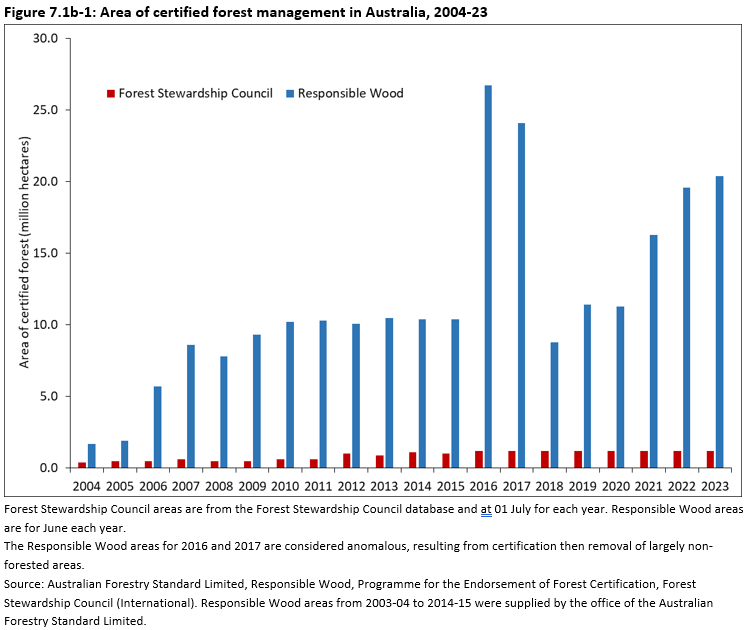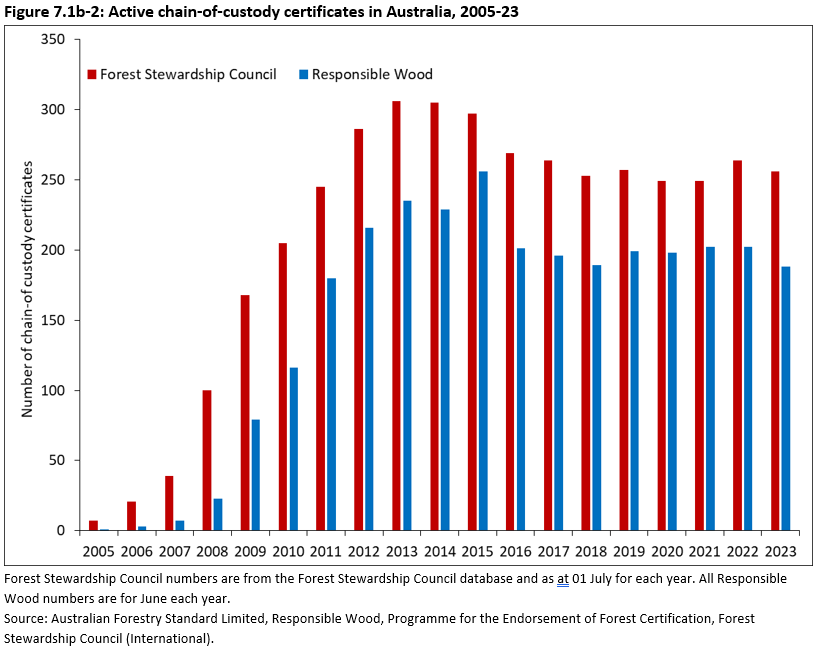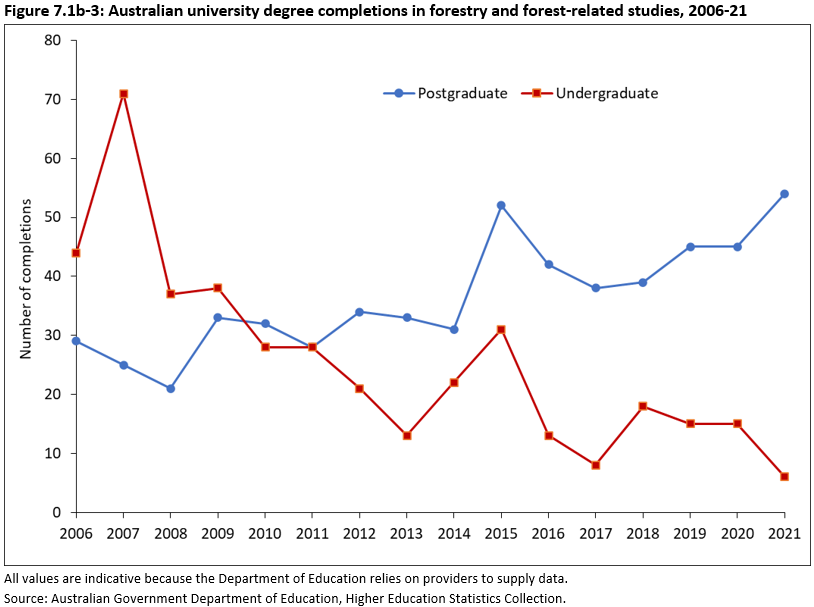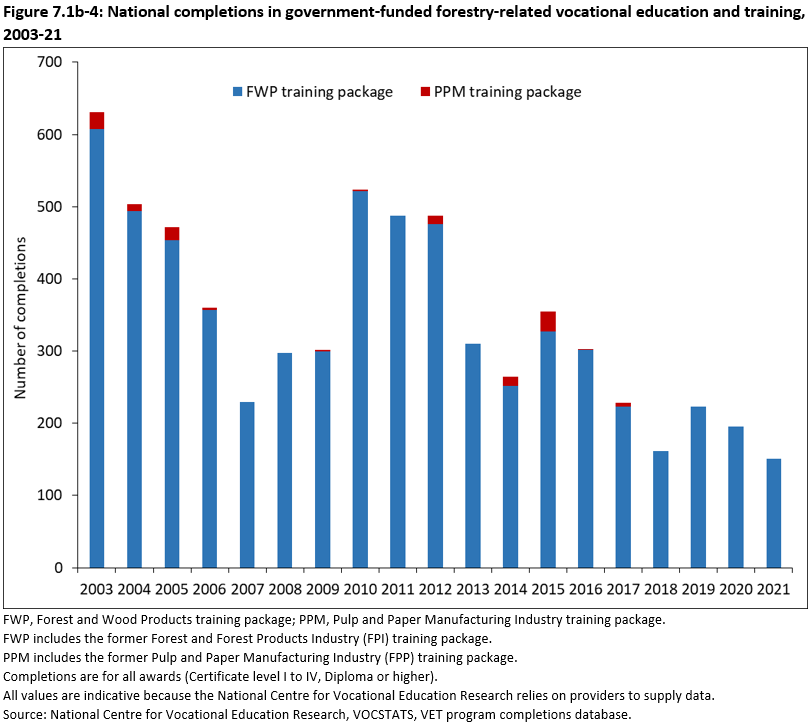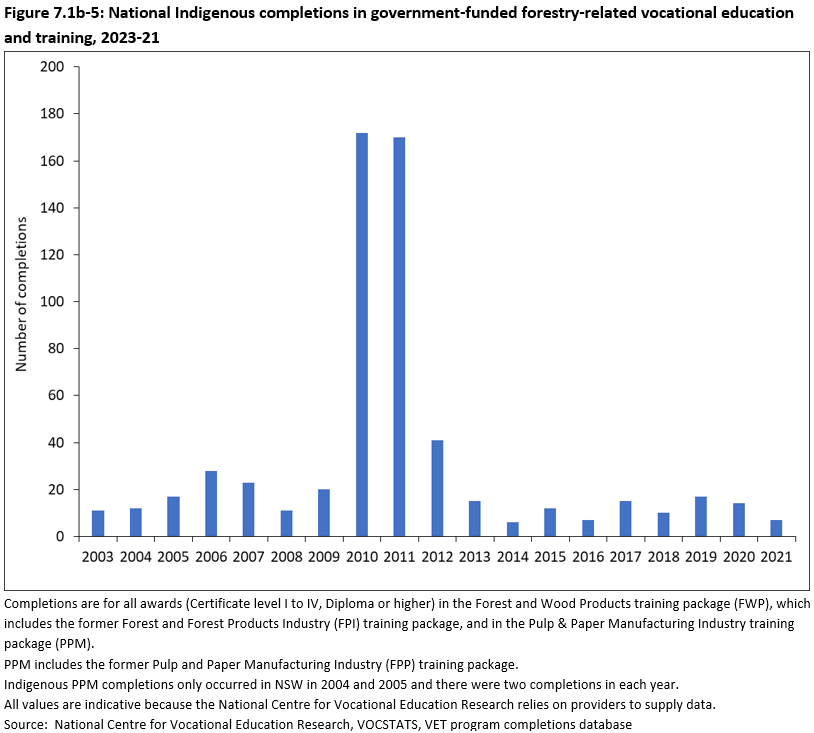This indicator examines the institutional frameworks that support sustainable forest management. Institutional frameworks provide mechanisms for engagement of the wider community in the process of continuous improvement and sustainable forest management.
This is the Key information for Indicator 7.1b, published July 2024.
- A well-established policy framework, guided by a National Forest Policy Statement, supports the conservation and sustainable management of Australia’s forests, both nationally and in all states and territories.
- Codes of forest practice and externally certified environmental management systems are used by forest managers to provide a structured approach to the planning and management of protection of the environment.
- The area of certified forest management in Australia as at June 2023 was 20.4 million hectares under the Responsible Wood certification scheme, and 1.2 million hectares under the Forest Stewardship Council scheme.
- For education and training in sustainable forest management, a decreasing trend in undergraduate degree completions in forestry and forest-related studies, and an increasing trend in postgraduate degree completions has occurred over the last two decades.
A well-established policy framework, guided by a National Forest Policy Statement, supports the conservation and sustainable management of Australia’s forests, both nationally and in all states and territories.
Most state and territory government organisations and agencies responsible for forest management operate under long-term national and state or territory policies, strategies and charters that influence the sustainable management of Australia’s forests (see Table 7.1b-1). The extent to which these arrangements provide for conservation and sustainable forest management varies among states and territories. Generally, these arrangements apply comprehensively in public forests, but to a lesser extent in private and leasehold forests (which are generally managed privately).
Table 7.1b-1: Key non-legislative policies, strategies and charters influencing the conservation and sustainable management of Australia's forests
Notes to Table 7.1b-1:
- A South Australian Forest and Wood Products Industry Policy Statement was the first step in implementing recommendations from the Blueprint for the Future South Australian Forest and Wood Products Industry 2014 to 2040. The statement reaffirmed the South Australian Government’s commitment to the management of South Australia’s plantation forests for all South Australians.
- The government of Victoria announced on 23 May 2023 the ending of native forest harvesting in Victoria’s State forests on 01 January 2024.
- The government of Western Australia announced on 08 September 2021 the ending of harvesting in most public native forest from January 2024.
- Except otherwise noted, Table 7.1b-1 updated January 2023.
- Source: State, territory and Australian Government agencies.
More information on Australia’s forest policy framework is available in Supporting information for Indicator 7.1b. This includes information on Australia’s National Forest Policy Statement, public and Indigenous participation in forest management planning, the monitoring of compliance with forest management codes and systems, and the future of public native forest harvesting.
The area of certified forest management in Australia at June 2023 was 20.4 million hectares under the Responsible Wood certification scheme, and 1.2 million hectares under the Forest Stewardship Council scheme (see Figure 7.1b-1). The area certified by Responsible Wood increased in 2021 and 2022 mainly due to additional areas of forest being certified by VicForests and the Western Australian Forest Products Commission. Almost all multiple-use public forest is certified under at least one certification scheme.
The total area certified at any point in time is difficult to determine accurately, as some forest areas are certified under both schemes; in addition, certificates are issued or cease at differing times, and the 'defined forest area' upon which certificates are based can be updated. The area of Australia’s forest certified by both the Responsible Wood scheme and the Forest Stewardship Council scheme was estimated at 1.06 million hectares in mid-2023.
Click here for a Microsoft Excel workbook of the data for Figure 7.1b-1.
Forest management certification is the voluntary, independent assessment of forest management activities and operations in a particular area of forest against a credible standard that has criteria, requirements and indicators encompassing environmental, economic, social and cultural values. Two forest certification schemes operate in Australia: an international scheme operated by the Forest Stewardship Council, and the Responsible Wood certification scheme, endorsed by the international Programme for the Endorsement of Forest Certification. Both schemes have forest management standards and chain-of-custody standards.
Certification of the management of a forest area is carried out by an accredited, third-party certification body against standards set out by a forest certification scheme. Certification schemes can require forest management practices to be more stringent than required by law alone. Forest certification can provide assurance to consumers, governments and enterprises that the forest and wood products they buy are legally harvested from sustainably managed forests. It also provides for community consultation in the management of forests covered by certification.
Chain-of-custody standards have criteria and requirements for assessing and tracking wood and forest products originating in certified forests through all phases of ownership, transportation and manufacturing, from a defined forest area to the final product delivered to the consumer. The number of active chain-of-custody certificates in Australia has remained relatively stable in recent years (Figure 7.1b-2).
Click here for a Microsoft Excel workbook of the data for Figure 7.1b-2.
A range of options for education and training continues to be available in Australia across areas relevant to sustainable forest management. The levels of education and training available include undergraduate, graduate and postgraduate degrees, coursework certificates and diplomas, and operational competency certificates.
Tertiary education
A decreasing trend in undergraduate degree completions in forestry and forest-related studies, and an increasing trend in postgraduate degree completions occurred over the last two decades (Figure 7.1b-3).
An undergraduate forestry degree is offered at one university in Australia. Other universities offer forestry or forest-related topics as part of science and environmental science undergraduate and postgraduate degrees. These degrees, along with graduate diplomas, continue to deliver graduates in forest-specific and forest-related study areas.
Fellowships, grants, and awards are available for professional development opportunities to those working in wood products or forestry industries or studying towards a career in wood products or forestry industries. The Joseph William Gottstein Memorial Trust Fund is a national educational trust fund promoting the development of Australia’s wood products and forestry industries in this way.
Click here for a Microsoft Excel workbook of the data for Figure 7.1b-3.
Vocational education and training
The Forest and Wood Products (FWP) and Pulp and Paper Manufacturing Industry (PPM) training packages offer vocational education and training in technical qualifications at certificate level and at diploma level, to support the forest, wood, and paper products industry sectors.
National completions in government-funded forestry-related vocational education and training (VET) have remained low since 2017 in the FWP training package, whereas no completions in the PPM training package have been reported since 2017 (Figure 7.1b-4).
The increase in national completions in 2010, 2011 and 2012 may be attributed to a boost in Australian Government funding at the time through the National Workforce Development Fund and the Skills Connect Fund. The decline in VET training completions since 2012 was in line with an overall decline in apprenticeships and traineeships across all industries in Australia. Tighter budgets led to reduced demand for accredited qualifications, and more focus on informal in-house approaches to skill development not requiring external payments to service providers. Industry also developed an increased preference for fee-for-service short courses and training in a broader range of skills than the technical skills previously delivered by registered training organisations. Such types of training are not captured by the National Centre for Vocational Education Research data collection (ForestWorks 2016).
The number of Indigenous completions has remained relatively steady since 2012 (after large numbers of completions were reported in Queensland in 2010 and 2011) (Figure 7.1b-5). Since 2012, Indigenous completions as a proportion of all national VET completions has varied between 2.3% (in 2016) and 7.6% (in 2019).
The FWP and PPM training packages offer vocational education and training in technical qualifications at certificate level and at diploma level, to support the forest, wood, and paper products industry sectors.
Click here for a Microsoft Excel workbook of the data for Figure 7.1b-4.
Click here for a Microsoft Excel workbook of the data for Figure 7.1b-5.
Further information
- Australia’s National Forest Policy Statement
- Public participation and awareness
- Indigenous community participation and awareness
- Monitoring of compliance with forest management codes and systems
- Statements by state governments on the future of wood harvesting in public native forests

